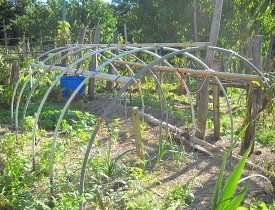DIY Gardening Project: Build a Hoop House
 “In terms of hoop houses, our goal is not to grow, but to prolong survival,” philosophizes Daniel Botkin, owner of Laughing Dog Farm. Botkin, who runs the many-layered, sustainable farm in Gill, MA, became avidly interested in the extended harvest possibilities of hoop houses about 17 years ago. “A trend developed and I got sucked in,” Botkin explains.
“In terms of hoop houses, our goal is not to grow, but to prolong survival,” philosophizes Daniel Botkin, owner of Laughing Dog Farm. Botkin, who runs the many-layered, sustainable farm in Gill, MA, became avidly interested in the extended harvest possibilities of hoop houses about 17 years ago. “A trend developed and I got sucked in,” Botkin explains.
What is a hoop house?
Hoop houses generally have the appearance of a Quonset hut. Steel bars or some type of wood are bent into an upside-down U shape and inserted into the ground several feet apart over a garden space. This frame is then covered with plastic which is not attached but simply held down by rocks or other heavy items.
While hoop houses can be virtually any size. Botkin recommends small home garden hoop houses afor protecting an average kitchen garden. Small hoop houses "... are essentially a larger form of cold frame,” states Botkin. To be able to work in the smaller hoop houses the gardener can either open the side skirts of the plastic, or crawl inside. “Some people create a trench in the middle of the hoop house to work from.”
Building a small hoop house can be easy and inexpensive
Botkin mentions that he was thinking one day about how plumbers bend pipe, which gave him the idea to create a simple “jig.” “Once people see this, it will go viral,” Botkin laughs. The jig was constructed with help from Botkin’s associate John DiMatteo. Here's how you DIY your own jig:
1. Find a sturdy wooden table to attach the jig to.
2. Cut a 2’6” radius piece of ½ “ plywood and bolt it to the center of the table, flush with the edge. (Essentially, it’s an arch or bow shape). “Plywood is good for its smoothness to make bending the pipes easier,” comments DiMatteo.
3. Bolt or nail a 8” piece of plywood above the center of the bow, allowing room for the steel pipes to be passed through.
How to bend the steel pipes for your hoop house
Using this simple jig, anyone can bend ¾ inch steel pipe easily. “Bend the pipe incrementally to create a perfect bow,” instructs Botkin. “You can build a nice sized (10’x6’x4’ high) hoop house in your backyard for about $100 using this method. And you don’t have to be a big, strong man to bend the pipes. It’s easy.”
1. You will need six or more 6’ steel pipes, depending on how long you want your hoop house to be.
2. Then insert the pipe one foot at a time into the channel and begin bending. “It’s important to keep everything level and flat,” DiMatteo remarks.
3. “When you get to the end, to that last foot of pipe, I just turn it around and work from the other end,” DiMatteo continues. “You never want to over-bend.”
Benefits of hoop house gardening
Hoop houses allow the gardener to control the temperature and environment for plants to remain in a stabilized state. “You can do harvesting each month starting in November. Not much actually grows and by the end of January, you mostly have brown nubs,” claims Botkin. “After Groundhog Day, the sun starts to return, the temperatures rise, and the greenery starts to come back to life.”
The only downside to gardening with a hoop house is the need to be aware and actively tending your plants -- as well as the structure itself -- depending on the weather. “You can’t just take a two-week trip to Florida and expect anything to be in good shape when you return.”
Snow and ice need to be kept off the hoop house as much as possible. Snow and ice build-up is the primary destroyer of hoop houses.
Plants that thrive in a hoop house
Botkin suggests that virtually any cold-hardy plant or herb would do well in a hoop house environment such as:
- Arugula
- Brassicas (broccoli, cabbages, cauliflower, etc.)
- Cilantro
- Root crops like beets, carrots, and turnips
“That’s the epiphany. You have a fantastic opportunity to prolong your harvest for many months,” he enthuses.
Cris Carl writes for networx.com.
Updated August 13, 2018.
Related Articles
Looking for a Pro? Call us (866) 441-6648

Landscaping Average Costs
Landscapers Experiences

Yard Cleanup By A Local Landscaper Who Cares About Customers

Seamless Extension Of Concrete Patio And Poolside Retaining Wall



